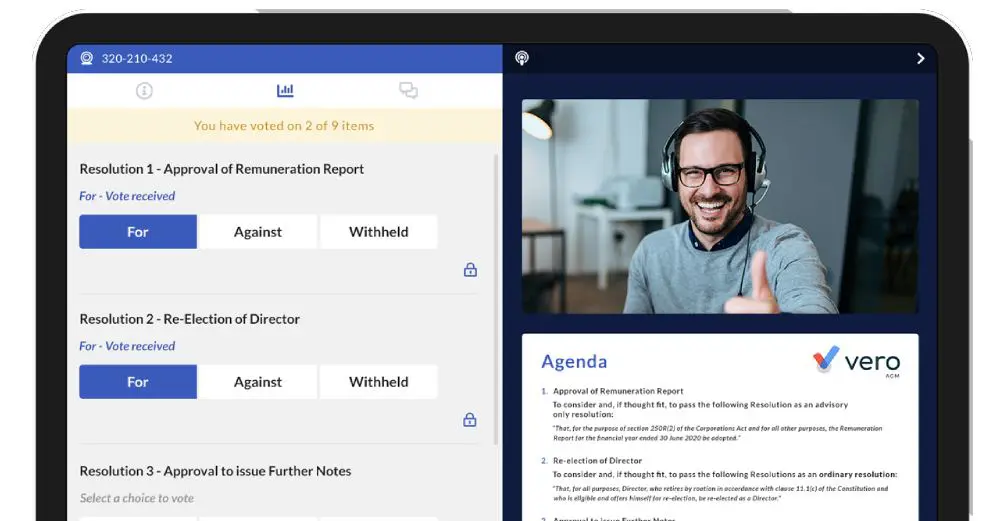What are the steps in preparing a motion at an AGM?
August 23, 2022

With online meetings allowing shareholders to participate electronically, holding a hybrid or virtual AGM has become a popular choice for companies that wish to make the process more accessible, simpler and easier for their members. Despite the convenience virtual AGMs bring, however, there are still factors to consider carefully, such as following the proper steps in preparing a motion.
A virtual AGM complies with the rules of a standard AGM. That includes complying with the general requirements of the meeting:
- All members must be notified of the type of meeting being held.
- All members must be notified of the exact date, time and place of the meeting.
- All members must be notified of the agenda of the meeting.
Moreover, the shareholders must be informed of matters regarding proxies and the tabled motions and resolutions from the previous meeting. They must also be given a copy of the documents relevant to the meeting.
Motions and resolutions
To discuss a business matter, a motion or proposal should be put forward. The shareholders then take a vote; a quorum must first be achieved to pass a motion. If and only if the motion has reached a quorum can it be considered valid. If the motion is passed, it then becomes a resolution.
Drafting a motion
For the shareholders to make a decision about something, putting forth a motion is necessary. Drafting a motion properly helps in ensuring the shareholders can make an accurate decision regarding the matter when it is discussed.
Be clear and concise in stating your motion so that there are no misunderstandings. Ensure that is also within legal means; consider if there are any special requirements that must be met to address the issue, such as complying with building regulations to approve a repair.
Also clearly specify the economic factors for the motion; inform if it already has an allocated fund in the budget or if a special levy has to be raised. Give a set timeframe for the motion. Detail the specific actions to be taken to resolve the issue.
Lastly, but most importantly, consider the feasibility of the motion. Ensure that it is achievable and is something that shareholders can support.
Putting forward a motion
After developing a clear and concise motion, submit the motion to the secretary with ample time before the meeting so that it can be included in the agenda.
During the meeting, follow the guiding procedures on how to put forward the motion.
- Introduce the motion to the meeting via the chairperson.
- A second member will agree to the motion by “seconding” it. If the motion is seconded, the members can proceed to put it into consideration. If not seconded, the motion will lapse.
- If the motion is seconded and put into consideration, the members can freely discuss the motion, whether for it or against it.
Voting on a motion
A motion that has been put into consideration and discussed can then be voted on by the members. If the motion is passed, it becomes a resolution.
The motion can be passed by ordinary resolution, special resolution, resolution without dissent or majority resolution.
An ordinary resolution is the most common type of resolution. It requires the motion to have more “yes” votes than “no” votes. If a member abstains from voting, it is not included in the count of the votes.
To pass a motion via special resolution, it must satisfy the following conditions:
- The motion receives in its favour 75% of the votes of the eligible voters that cast their vote at the meeting.
- The votes against the motion must not be more than 25% of the total number of eligible voters that cast their vote at the meeting.
For a resolution without dissent, the motion must have no votes against it. Abstained votes are not included in the count.
Majority resolutions are achieved when the votes in favour of the motion are more than 50% of the votes cast. If a voter abstains, their vote is not included in the count.
A resolution is a binding decision that must be followed as long as the members deciding on it are authorised to do so. It can be rescinded during the same meeting using the same procedures for moving and adopting it.
The minute taker formally documents the resolution in the minutes, including its details and the names of the mover and seconder. The mover or other members can follow up on the resolution later, with the understanding of the time frame needed to complete it as well as who will be responsible for enacting it.
Voting solutions for AGM
For a successful vote during a virtual AGM, a suitable voting platform is necessary. The integrity of the voting process and the results will depend on the chosen voting solutions. Therefore, the voting solutions should have reliable security to protect the voters’ privacy and data. It should also have customisable features that can be adapted to suit the organisation’s specific needs. Enhanced accessibility and flexibility will also help in ensuring that the platform can properly function on any device the users have.
The virtual format is an excellent way to boost the effectiveness and efficiency of your AGM, giving participants a chance to fully discuss business matters using intelligent solutions that provide real-time data. Virtual AGMs also give more accurate results and are even encouraging better turnouts, since they allow members to participate wherever they are.
As the trend of virtual AGMs continues to rise, it is important to choose an elegant and efficient platform that can reliably and securely provide the online meeting solutions you require.
Email us at info@verovoting.com.au or contact us here for more information.


